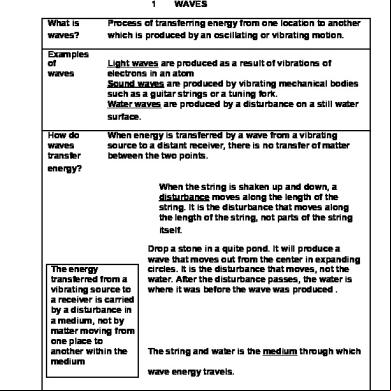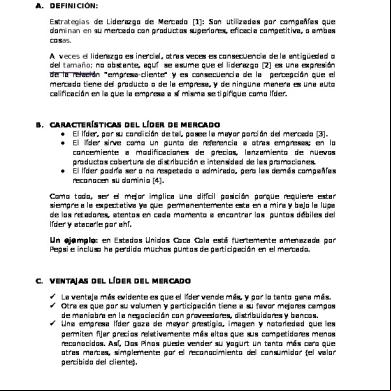Chapter 1 A Physics Toolkit S 1f3x5d
This document was ed by and they confirmed that they have the permission to share it. If you are author or own the copyright of this book, please report to us by using this report form. Report 2z6p3t
Overview 5o1f4z
& View Chapter 1 A Physics Toolkit S as PDF for free.
More details 6z3438
- Words: 1,125
- Pages: 9
1 A PHYSICS TOOLKIT Understanding Physics Concepts Circle the letter of the choice that best completes the statement or answers the question.
1. The base SI unit for length is the _____ . a. foot
c. meter
b. inch
d. kilogram
2. The metric prefix that means 1×106 is _____ . a. pico
c. nano
b. mega
d. giga
3. To avoid parallax errors, laboratory instruments should be read _____ . a. at eye level
c. below eye level
b. from the side
d. at all of these positions
4. How many significant figure are in the measurement 2.560×104? a. 1
c. 3
b. 2
d. 4
5. A sample weighs 28.40 g. Which is the estimated digit? a. 2
c. 4
b. 8
d. 0
For each statement below, write true or rewrite the italicized part to make the statement true.
6. ________________________
In a scientific method, deductions are tested to find out whether they are valid.
7. ________________________
The degree of exactness of a measurement is called accuracy.
8. ________________________
Other scientists must be able to recreate an experiment and obtain similar data.
9. ________________________
The last digit in any measurement is the significant figure.
10.
________________________ areChapter significant. 1 A Physics Toolkit
All the zeros in 2,000,000
1 Copyright © Glencoe/McGraw-Hill, a division of The McGraw-Hill Companies, Inc.
Chapter 1 A Physics Toolkit
2 Copyright © Glencoe/McGraw-Hill, a division of The McGraw-Hill Companies, Inc.
1 Answer the following questions. Use complete sentences.
11.
Describe the methods that physicists use to study problems.
_____________________________________________________________________________ _____________________________________________________________________________ _____________________________________________________________________________ 12.
Describe two applications that resulted from the work of physicists.
____________________________________________________________________________ _ _____________________________________________________________________________ _____________________________________________________________________________ 13. Which of the following is a more precise measurement—the length of a tabletop measured with a stick calibrated in centimeters as shown on the left or the length measured with a stick calibrated in millimeters as shown on the right? Why?
____________________________________________________________________________ _ _____________________________________________________________________________ _____________________________________________________________________________ 14. Express each of the measurements in the diagram above in centimeters.
____________________________________________________________________________ _ 6. How many significant digits are in each of the following measurements? a. 3809 m
Chapter 1 A Physics Toolkit
3 Copyright © Glencoe/McGraw-Hill, a division of The McGraw-Hill Companies, Inc.
b. 9.013 m c. 0.0045 m 7. What is the difference between accuracy and precision?
____________________________________________________________________________ _ _____________________________________________________________________________ _____________________________________________________________________________
Chapter 1 A Physics Toolkit
4 Copyright © Glencoe/McGraw-Hill, a division of The McGraw-Hill Companies, Inc.
1 Thinking Critically Circle the letter of the choice that best completes the statement or answers the question.
1. The slope of a straight-line graph is the rise _____ the run. a. added to
c. multiplied by
b. subtracted from
d. divided by
2. A _____ is the current best explanation for why things work they way they do.
3.
a. theory
c. method
b. hypothesis
d. prediction
A line drawn as close as possible to all data points is called the _____ . a. linear relationship
c. vertical value
b. line of best fit
d. parabola
4. One of the scientist’s most useful tools for making predictions is the _____ . a. SI unit
c. graph
b. significant digit
d. measurement
5. Which equation is most closely associated with an inverse relationship. a. y = mx + b b. m =
c. y = ax2 + bx + c
∆y ∆x
d. y =
a x
6. Which of the following must be included in the horizontal-axis label of a graph? a. the graph title
c. a unit of measurement
b. the variable “time”
d. the slope
7. Which of the following is not an SI base unit? a. meter
c. Celsius
b. kilogram
d. second
For each of the statements below, write true or rewrite the italicized part to make the statement true.
8. ________________________
The units used to label the answer to a physics problem may change when you multiply or divide.
9. ________________________
A graph in the shape of a parabola represents an inverse relationship.
10.
________________________ The factor that is changed or manipulated during an experiment is the independent variable.
11.
________________________ When constructing a graph from data, the range of the x-axis is determined by the range of the dependent variable. Chapter 1 A Physics Toolkit
5 Copyright © Glencoe/McGraw-Hill, a division of The McGraw-Hill Companies, Inc.
12.
________________________ A graph in the shape of a hyperbola represents an inverse relationship.
13.
________________________ a quadratic relationship.
A straight line represents
Chapter 1 A Physics Toolkit
6 Copyright © Glencoe/McGraw-Hill, a division of The McGraw-Hill Companies, Inc.
1 Answer the following questions.
14.
Express the measurements in scientific notation. a. 142,000 s
______________________________________________________________________ b. 0.00809 kg
______________________________________________________________________ c. 501,000,000 m
______________________________________________________________________ 15. Simplify the following expressions. Give your answers in scientific notation, using the correct number of significant digits. a. (2×106 m)(5×105 m)
______________________________________________________________________ b.
12× 106 m 4 × 102 s
______________________________________________________________________ c. (5.06×102 m) + (8.124 km)
______________________________________________________________________ 8. Describe the relationship between the variables shown in the graph below. What is the general equation that is used to represent this type of relationship?
____________________________________________________________________________________ ____________________________________________________________________________________ ____________________________________________________________________________________ Chapter 1 A Physics Toolkit
7 Copyright © Glencoe/McGraw-Hill, a division of The McGraw-Hill Companies, Inc.
1 Applying Physics Knowledge Answer the following questions. Use complete sentences.
1. Which of the following measurements contains zeros that are not significant? Give a reason for your answer. 3.050×105 mm 0.0053 m 45.020 cm 101.2 g ____________________________________________________________________________________ ____________________________________________________________________________________ ____________________________________________________________________________________ ____________________________________________________________________________________ 2. How are independent and dependent variables related? Identify the graph axis on which each type of variable would be plotted. ____________________________________________________________________________________ ____________________________________________________________________________________ ____________________________________________________________________________________ ____________________________________________________________________________________ ____________________________________________________________________________________ Answer the following questions. Show your calculations.
3. The total mass of four containers is 5.000 kg. If the mass of container A is 256 mg, container B is 5117 cg, and container C is 382 g, what is the mass of container D?
4. Show that the measurements below are equivalent. 5687 nm, 0.00005687 dm
Chapter 1 A Physics Toolkit
8 Copyright © Glencoe/McGraw-Hill, a division of The McGraw-Hill Companies, Inc.
1 5. The results of a class experiment investigating the relationship between mass and acceleration are shown in the table below. The force applied to each mass remained constant. Mass (kg)
Acceleration (m/s2)
0.5
6.0
1.0
3.0
1.5
2.0
2.0
1.5
2.5
1.2
3.0
1.0
a. Plot the values given and draw the curve that best fits the points.
b. Describe the resulting curve.
______________________________________________________________________ c. What is the relationship between mass and the acceleration produced by a constant force?
______________________________________________________________________ d. What is the general equation for the relationship shown in the graph?
______________________________________________________________________ ______________________________________________________________________ 6. Convert 86 km/h to m/s. Chapter 1 A Physics Toolkit
9 Copyright © Glencoe/McGraw-Hill, a division of The McGraw-Hill Companies, Inc.
1. The base SI unit for length is the _____ . a. foot
c. meter
b. inch
d. kilogram
2. The metric prefix that means 1×106 is _____ . a. pico
c. nano
b. mega
d. giga
3. To avoid parallax errors, laboratory instruments should be read _____ . a. at eye level
c. below eye level
b. from the side
d. at all of these positions
4. How many significant figure are in the measurement 2.560×104? a. 1
c. 3
b. 2
d. 4
5. A sample weighs 28.40 g. Which is the estimated digit? a. 2
c. 4
b. 8
d. 0
For each statement below, write true or rewrite the italicized part to make the statement true.
6. ________________________
In a scientific method, deductions are tested to find out whether they are valid.
7. ________________________
The degree of exactness of a measurement is called accuracy.
8. ________________________
Other scientists must be able to recreate an experiment and obtain similar data.
9. ________________________
The last digit in any measurement is the significant figure.
10.
________________________ areChapter significant. 1 A Physics Toolkit
All the zeros in 2,000,000
1 Copyright © Glencoe/McGraw-Hill, a division of The McGraw-Hill Companies, Inc.
Chapter 1 A Physics Toolkit
2 Copyright © Glencoe/McGraw-Hill, a division of The McGraw-Hill Companies, Inc.
1 Answer the following questions. Use complete sentences.
11.
Describe the methods that physicists use to study problems.
_____________________________________________________________________________ _____________________________________________________________________________ _____________________________________________________________________________ 12.
Describe two applications that resulted from the work of physicists.
____________________________________________________________________________ _ _____________________________________________________________________________ _____________________________________________________________________________ 13. Which of the following is a more precise measurement—the length of a tabletop measured with a stick calibrated in centimeters as shown on the left or the length measured with a stick calibrated in millimeters as shown on the right? Why?
____________________________________________________________________________ _ _____________________________________________________________________________ _____________________________________________________________________________ 14. Express each of the measurements in the diagram above in centimeters.
____________________________________________________________________________ _ 6. How many significant digits are in each of the following measurements? a. 3809 m
Chapter 1 A Physics Toolkit
3 Copyright © Glencoe/McGraw-Hill, a division of The McGraw-Hill Companies, Inc.
b. 9.013 m c. 0.0045 m 7. What is the difference between accuracy and precision?
____________________________________________________________________________ _ _____________________________________________________________________________ _____________________________________________________________________________
Chapter 1 A Physics Toolkit
4 Copyright © Glencoe/McGraw-Hill, a division of The McGraw-Hill Companies, Inc.
1 Thinking Critically Circle the letter of the choice that best completes the statement or answers the question.
1. The slope of a straight-line graph is the rise _____ the run. a. added to
c. multiplied by
b. subtracted from
d. divided by
2. A _____ is the current best explanation for why things work they way they do.
3.
a. theory
c. method
b. hypothesis
d. prediction
A line drawn as close as possible to all data points is called the _____ . a. linear relationship
c. vertical value
b. line of best fit
d. parabola
4. One of the scientist’s most useful tools for making predictions is the _____ . a. SI unit
c. graph
b. significant digit
d. measurement
5. Which equation is most closely associated with an inverse relationship. a. y = mx + b b. m =
c. y = ax2 + bx + c
∆y ∆x
d. y =
a x
6. Which of the following must be included in the horizontal-axis label of a graph? a. the graph title
c. a unit of measurement
b. the variable “time”
d. the slope
7. Which of the following is not an SI base unit? a. meter
c. Celsius
b. kilogram
d. second
For each of the statements below, write true or rewrite the italicized part to make the statement true.
8. ________________________
The units used to label the answer to a physics problem may change when you multiply or divide.
9. ________________________
A graph in the shape of a parabola represents an inverse relationship.
10.
________________________ The factor that is changed or manipulated during an experiment is the independent variable.
11.
________________________ When constructing a graph from data, the range of the x-axis is determined by the range of the dependent variable. Chapter 1 A Physics Toolkit
5 Copyright © Glencoe/McGraw-Hill, a division of The McGraw-Hill Companies, Inc.
12.
________________________ A graph in the shape of a hyperbola represents an inverse relationship.
13.
________________________ a quadratic relationship.
A straight line represents
Chapter 1 A Physics Toolkit
6 Copyright © Glencoe/McGraw-Hill, a division of The McGraw-Hill Companies, Inc.
1 Answer the following questions.
14.
Express the measurements in scientific notation. a. 142,000 s
______________________________________________________________________ b. 0.00809 kg
______________________________________________________________________ c. 501,000,000 m
______________________________________________________________________ 15. Simplify the following expressions. Give your answers in scientific notation, using the correct number of significant digits. a. (2×106 m)(5×105 m)
______________________________________________________________________ b.
12× 106 m 4 × 102 s
______________________________________________________________________ c. (5.06×102 m) + (8.124 km)
______________________________________________________________________ 8. Describe the relationship between the variables shown in the graph below. What is the general equation that is used to represent this type of relationship?
____________________________________________________________________________________ ____________________________________________________________________________________ ____________________________________________________________________________________ Chapter 1 A Physics Toolkit
7 Copyright © Glencoe/McGraw-Hill, a division of The McGraw-Hill Companies, Inc.
1 Applying Physics Knowledge Answer the following questions. Use complete sentences.
1. Which of the following measurements contains zeros that are not significant? Give a reason for your answer. 3.050×105 mm 0.0053 m 45.020 cm 101.2 g ____________________________________________________________________________________ ____________________________________________________________________________________ ____________________________________________________________________________________ ____________________________________________________________________________________ 2. How are independent and dependent variables related? Identify the graph axis on which each type of variable would be plotted. ____________________________________________________________________________________ ____________________________________________________________________________________ ____________________________________________________________________________________ ____________________________________________________________________________________ ____________________________________________________________________________________ Answer the following questions. Show your calculations.
3. The total mass of four containers is 5.000 kg. If the mass of container A is 256 mg, container B is 5117 cg, and container C is 382 g, what is the mass of container D?
4. Show that the measurements below are equivalent. 5687 nm, 0.00005687 dm
Chapter 1 A Physics Toolkit
8 Copyright © Glencoe/McGraw-Hill, a division of The McGraw-Hill Companies, Inc.
1 5. The results of a class experiment investigating the relationship between mass and acceleration are shown in the table below. The force applied to each mass remained constant. Mass (kg)
Acceleration (m/s2)
0.5
6.0
1.0
3.0
1.5
2.0
2.0
1.5
2.5
1.2
3.0
1.0
a. Plot the values given and draw the curve that best fits the points.
b. Describe the resulting curve.
______________________________________________________________________ c. What is the relationship between mass and the acceleration produced by a constant force?
______________________________________________________________________ d. What is the general equation for the relationship shown in the graph?
______________________________________________________________________ ______________________________________________________________________ 6. Convert 86 km/h to m/s. Chapter 1 A Physics Toolkit
9 Copyright © Glencoe/McGraw-Hill, a division of The McGraw-Hill Companies, Inc.










